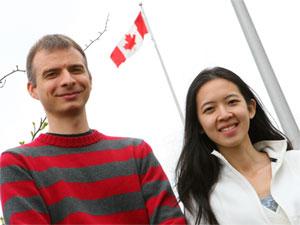 |
| Hannes Hochreiner, from Austria, and Eugenia Chock, from Malaysia are delighted by the changes to work permits for international students. (Nick Pearce Photo) |
About to graduate with his PhD from Dalhousie, Hannes Hochreiner says he was “really quite concerned” about what to do next.
With his student permit about to expire and a job offer not yet in hand, the international student from Austria admits with furrowed brow that the words “quite concerned” don’t come close to expressing the mounting anxiety he was feeling as convocation ceremonies approached.
But all his worries dissipated once he heard Ottawa was introducing changes to work permits for international students. Under the old rules, Mr. Hochreiner would have been forced to return his native country unless he found a job in his field of study within 90 days.
|
“While having all this education, I want to put it to good use,” says Mr. Hochreiner, 30, a chemist who specializes in the modeling of fibre optics sensors. “Before, it was so complicated to explain to employers how (the system) worked. Now I just have to check a box.”
In addition, the duration of the work permit has been extended to three years across the country. Previously, the program only allowed international students to work for one or two years, depending on the location. As well, students are no longer restricted to finding jobs related to their degree.
Mr. Hochreiner’s reaction was a low-key “phew.” But Margaret Wood, international student advisor at pilipiliÂţ», wasn’t nearly so restrained: “I’m sure my cheer could have been heard from here to Ottawa.”
She says the changes will alleviate significant stress for international students who want to remain in Canada to work—and perhaps to live permanently—after graduation.
And that’s the whole idea. “The government wants more foreign students to choose Canada and we want to help them succeed,” Ms. Finley said in a news release. “Open and longer work permits provide international students with more opportunities for Canadian work experience and skills development. This will, in turn, help make Canada a destination of choice, and help us keep international students already studying in Canada.”
International Student and Exchange Services will hold an information session on Friday, May 2 at 2 p.m. in the MacMechan Auditorium, Killam Library. Ms. Wood says it’s an opportunity for international students to ask questions “because every case is a special case.”
Eugenia Chock is one of those special cases. A medical student from Malaysia, the 24-year-old student did half her degree in her native country, the other half in Canada. Without permanent residency status, she explained that she couldn’t qualify for post-graduate training in Canada.
At least now, she’ll be able to apply for and secure the necessary work experience to be eligible to apply for permanent-residency. Ms. Chock feels strongly that post graduate medical training is an extremely important next step in her education and she would like to do it in Canada.
All in all, the changes should eliminate a lot of the red tape that trips up students who come to Canada for their degrees. “Now they can focus on their academics and not have to deal with the challenges of bureaucracy,” says Ms. Wood.
In 2006-07, more than 1,100 international students from 100 countries came to study at pilipiliÂţ». Across the country, 63,673 international students were in Canada to study, a 4.6 per cent increase over 2006-05 figures.
